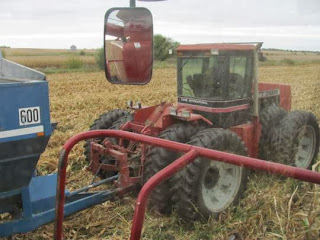It's harvest time in Iowa. And for one day last week, I was once again riding in the combine and reliving a hundred memories from my childhood.
I am always drawn to a rustling cornfield -- not just for the crackling sound of leaves, but also for the musty scent of drying cornstalks, the perfect symmetry of the rows, and a deep-rooted rural pride in seeing a job nearing its completion.
Violet and I stood at one end of the field, waiting for my dad to approach in the combine. Like a great beast slowly lumbering toward us, I wondered if Violet would be scared by the roar of the engine, but was surprised at how quiet this new combine is compared to the noisy, near defeaning ones of my childhood.
When you live in the country, your first combine ride is as important as your first steps, your first tooth or your first word. It's a rite of passage for becoming a farm kid.
Like an airplane pilot, farm kids will log 100s of hours riding in combines and tractors before they're given their chance behind the wheel. I remember all the warm, sunny afternoons I spent in combines and tractors. There were no ride-along seats back then. We were just wedged in the corner behind the driver. It was a bumpy ride, and one sure to put you to sleep after awhile.
Never been inside a combine? Here's the view from the driver's seat looking down. You're seeing the cornstalks at the moment they're cut by the blades and then pulled through the combine where the stalks are ground up and the ears of corn are shelled from the cob. The process takes just seconds -- a marvel of modern engineering.
Portrait of an Iowa farmer
You can see the silhouette of my dad at the wheel of the combine, this window is what is directly behind him -- the hopper with all the shelled corn.
When the hopper is full, the combine driver empties the load of shelled corn into a waiting grain wagon or semi-trailer. At the left, you can see the auger on the combine where the corn pours out. Often the tractor with the empty wagon will pull up beside the moving combine, keeping pace as the combine continues to harvest and empty its hopper at the same time.
Violet is part of the first generation of my dad's family where none of them live on a farm. It makes me sad to think that after generations and generations of farmers strewn throughout the branches of our family tree, it could all end when my dad retires.
The newest models of combines don't need drivers for most of the driving. Robotic steering and GPS do most of the work. But Dad's combine still requires at least one hand on the wheel, and the other on a joystick that controls the height of the combine blades -- lowering and raising them as needed to allow for ground that's not level and wayward growing stalks of corn.
I liked this picture of Violet and Dad's hands on the wheel together.
If you can see, behind Dad and Violet the window is completely filled with corn. If there's no empty wagon, you have to wait for the next one before combining anymore. As we waited for Grandpa Keith to arrive with the empty wagons, we chatted about a farming article my Uncle Tobin had sent about the price of farmland in Iowa. Going for more than $20,000 an acre in some counties, Iowa farmland prices have risen more than 80 percent in the past few years. That makes it pretty tough, if not impossible for guys like my dad to expand their farms. Even worse, longtime landlords -- absentee land owners who rent their land out to local farmers to farm it -- are now selling their land while prices are high, taking away acres from farmers who have farmed them for decades.
There's Grandpa in the red tractor -- his job is to drive the full wagons of corn into town where the elevator is located. There, he waits in line to weigh and unload the corn. Each full wagon is weighed on a big scale before it's emptied into the huge grain bins. They also test the moisture level and quality of the corn. If the corn is too wet, you don't make as much money.
Once the wagon is unloaded, you head back to the field where it's likely the next wagons are already filled and waiting for you to take them to town. It's a monotonous process that has to be performed quickly before the weather turns, the prices drop or the equipment breaks.
Farming has always been a gamble. I admire the men and women who devote their lives to growing crops and raising animals so the rest of us don't have to worry about where our food comes from.
I loved spend one more afternoon in the combine, introducing my daughter to Iowa agriculture. I hope she will be proud to be a farmer's granddaughter, just as I have always been proud to be a farmer's daughter.














No comments:
Post a Comment